Amazon: Yahoo Finance's 2017 Company of the Year
Nowhere was Amazon’s position as a retail juggernaut better symbolized than a photograph last July of a buff Jeff Bezos strutting around Sun Valley, Idaho, “guns” blazing. The shot of the CEO, which went viral and inspired a stream of breathless coverage like GQ Magazine’s “Jeff Bezos’ big-ass biceps will shame you into working out this weekend,” served as a stark symbol of how far he and Amazon have come since Bezos jump-started Amazon in his Seattle garage to peddle books online.
Amazon (AMZN) still sells books, of course. But it does so much more now, from cloud-based services to food delivery, much to the delight of more than 300 million shoppers spoiled by its competitive pricing and fast shipping.
While Amazon continues to account for a relatively small share of retail overall, the company continuously made business headlines.
The e-commerce giant’s broad reach is also drawing the attention of lawmakers like Senator Cory Booker, who argue that big tech companies like Amazon and Google have simply become too big and should face greater antitrust scrutiny.
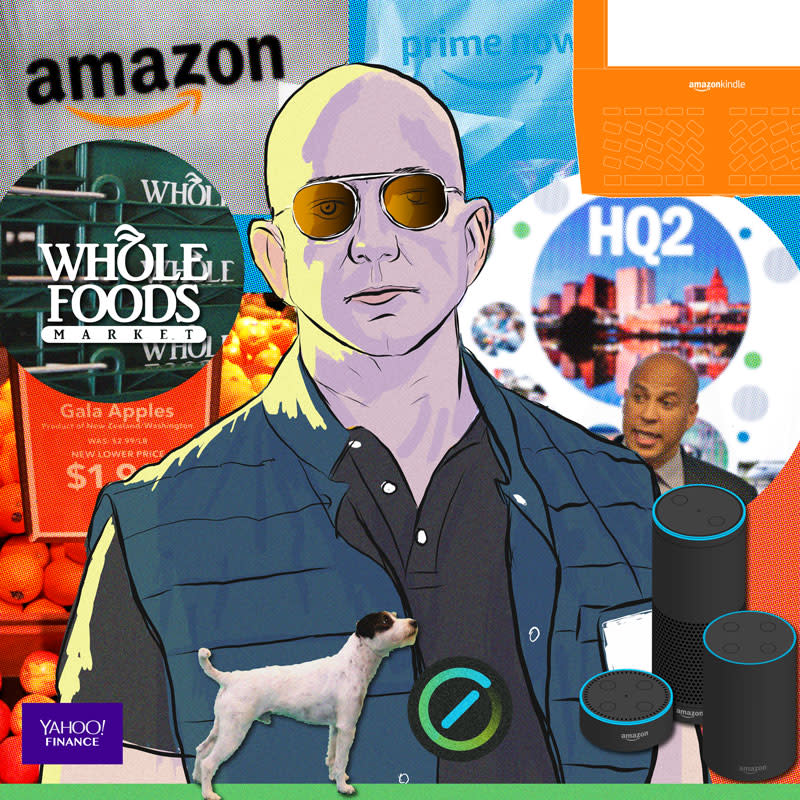
Indeed, Amazon’s massive size and influence is part of the reason why, when the time came once again for Yahoo Finance’s editors to select a Company of the Year, the answer was clear. Amazon — which has innovated, moved markets, and pushed boundaries — joins past winners such as Facebook (FB), Disney (DIS), and Nvidia (NVDA). While it might seem like an obvious choice for Company of the Year, there’s no denying that 2017 was huge for Amazon.
To be sure, Amazon wasn’t the market’s strongest performer in 2017. Still, Amazon shares soared nearly 60% in 2017 — following moves like the $13.7 billion Whole Foods deal, strong quarterly earnings, Amazon Web Services’ $18 billion annual revenue run rate, and reports that Amazon could break into pharmaceuticals. At the same time, Alexa became the undisputed market leader for voice assistants.
But while Amazon’s achievements up-to-date are praiseworthy (see our timeline for Amazon’s path to domination in 2017), some of the company’s most exciting offerings appear yet to come.
‘We’re not focused on conquering’
“Our focus is pioneering,” Amazon Worldwide Consumer CEO Jeff Wilke told Yahoo Finance recently during an interview at the company’s Santa Monica, California, offices. “We’re not focused on conquering. That’s a business model some people could choose, but we’re trying to invent — not disrupt. If customers like what we’ve invented, they’re going to choose our invention sometimes, and that may lead to disruption for others, but we expect it to accelerate invention and there will be more opportunity for others to build great models, too.”
Despite Wilke’s assertions, disrupt is what Amazon did, so much so that Amazon was cited over 2,000 times on corporate earnings calls this year. One of the year’s largest deals — CVS’s (CVS) $69 billion acquisition of health insurer Aetna (AET) — is viewed by many pundits as a preemptive strike should Amazon barrel into pharmaceuticals the way it has into other areas like retail, groceries and food delivery.
“That seems to be the nature in which every business operates now,” RBC Capital Markets analyst George Hill explains, pointing to moves like Target’s (TGT) $550 million acquisition of Shipt, a same-day delivery company, which was announced in December. “Has Amazon led this charge? Absolutely. As Amazon continues to up its game in owning the ‘last mile’, they’re going to force every participant to up their game, as well.”
Amazon’s obsession with that “last mile” — the final journey of an order from the warehouse to the shopper’s doorstep — has forced virtually every retailer to rethink delivery since the tech giant launched Amazon Prime’s two-day delivery in 2005 and spearheaded an all-out arms race for faster shipping. Before Prime, anyone who wanted their orders quickly would have to pay FedEx or UPS big bucks or just have to wait. Now two-day or same-day shipping is the norm for an estimated 90 million Prime members, or 63% of Amazon customers in the U.S.
A “genius” acquisition
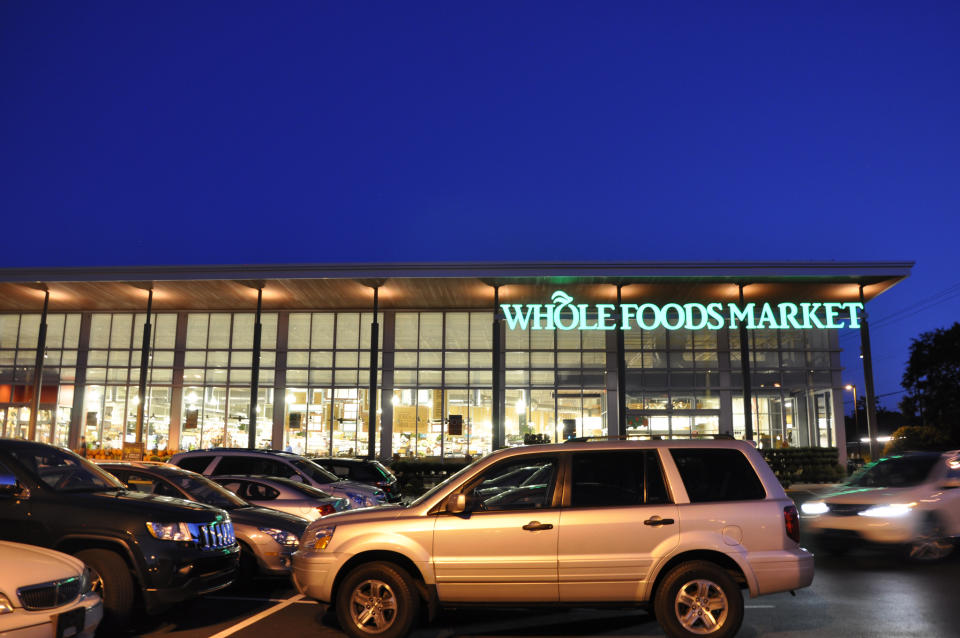
The tech giant’s boldest move this year was also its most surprising. In June, Amazon announced it would acquire Whole Foods for $13.7 billion — its largest acquisition to date. Although it toyed with groceries before — most visibly with an in-house groceries delivery service called Amazon Fresh — the Whole Foods acquisition was by far Amazon’s biggest signal yet that it is serious about expanding its overall presence in brick-and-mortar retail, starting with taking over Whole Foods’ 460-plus stores.
Scott Galloway, a professor of marketing at at NYU Stern School of Business and author of the book, “The Four: The Hidden DNA of Amazon, Apple, Facebook, and Google” calls Amazon’s acquisition of Whole Foods the second-best acquisition of the decade — second only to Facebook’s (FB) $1 billion acquisition of the popular photo-sharing app Instagram in 2012.
“For Amazon, buying Whole Foods was genius,” Galloway contends. “It gives them access to the wealthiest refrigerators in the world, one of the best and largest consumer brands in the world and lets them pick up 500 new warehouses all in one purchase.”
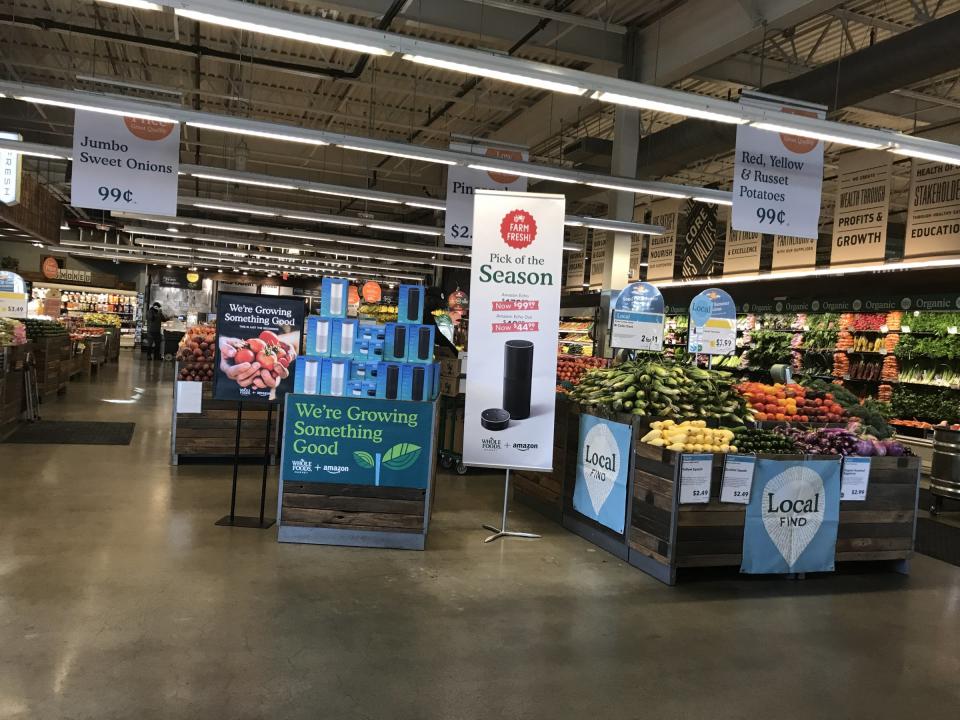
The effect on competition was immediate. That same Thursday in August when Amazon announced it would cut prices, Kroger (KR), Sprouts Farmers Market (SFM), SuperValu (SVU), Costco (COST), Target, and Wal-Mart Stores (WMT) stock all took a nosedive.
Whole Foods, meanwhile, saw new life after announcing its sixth consecutive quarter of falling same-store sales early this year. Foot traffic to its stores jumped 17% year-over-year during the week Amazon initially cut prices, according to the data analytics firm Thasos Group. Of those new shoppers, 24% came from Walmart, 16% came from Kroger, and 15% crossed over from Costco.
“The purpose of the acquisition was very simple: we’re fans,” explained Wilke, who added that the grocery chain’s healthier selection helped change the way he consumed food soon after he relocated from Pittsburgh 18 years ago to work with Bezos at Amazon. “I think we had a great opportunity to partner with a terrific company and a great brand. They essentially invented the natural and organic category.”
Amazon’s other home run
Amazon may not have invented the voice assistant, but that doesn’t seem to matter to the tens of millions of shoppers who now own an Echo speaker. According to estimates from digital research firm eMarketer, the Echo cornered roughly 70% of the U.S. market for voice-controlled speakers this year. You knew Alexa had entered the pop culture lexicon when “Saturday Night Live” aired its geriatric-themed spoof in May.
Unlike Apple (AAPL), which keeps Siri under lock and key, Amazon early on opened up access to Alexa so outside companies and developers could develop functions for it, even integrate it into their own devices. It was a risky business move, to be sure, but one that turned out to be a masterstroke. At last January’s Consumer Electronics Show, hundreds of Alexa-enabled devices from outside parties — fridges, self-driving cars, even baby monitors — lined the convention halls.
“We envisioned Alexa and all the products that connect to her to be based mostly in the cloud, and I think that’s the kind of paradigm shift that we’ve seen with this technology as opposed to previous technologies in consumer electronics, because Alexa being up in the cloud allows us to improve her every single day,” Dave Limp, Amazon SVP of devices and services, told Yahoo Finance at Amazon’s Seattle headquarters recently. “And because developers can extend her through software skills and through hardware partners, you’re seeing her now in refrigerators and cars and baby monitors and cameras.”
The hunt for HQ2
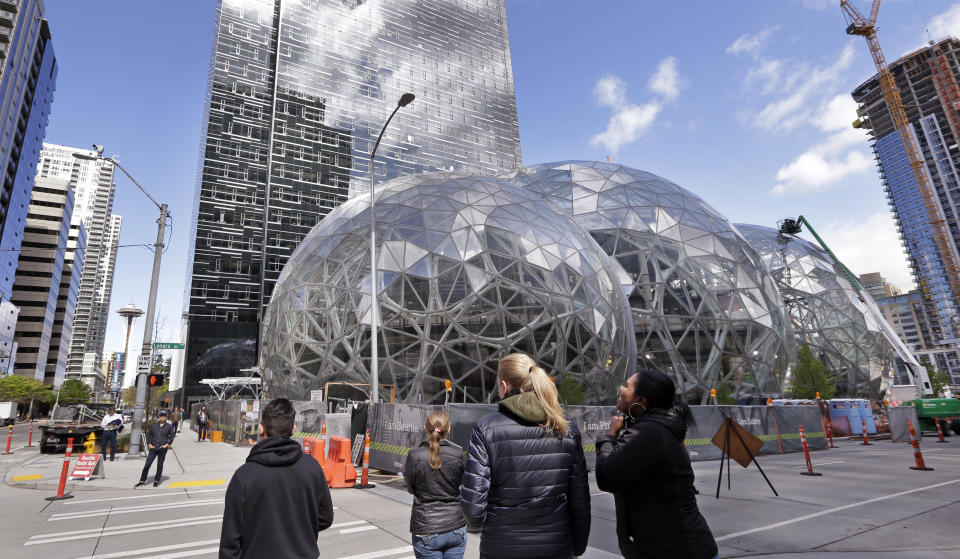
As Amazon expanded its brick-and-mortar footprint in 2017, it also made headlines by announcing it planned on opening a second headquarters somewhere else in the U.S, dubbed HQ2, with an estimated cost of $5 billion.
Soon after, the tech giant received 238 proposals from across North America, several of which got creative in wooing Amazon. Arizona representatives sent Amazon a 21-foot cactus, and a Pittsburgh sandwich chain offered to feed every Amazon employee. But the city of Stonecrest, Georgia, dangled the most outrageous deal of them all in offering to create an entirely new city called “Amazon” where Bezos could serve as mayor “for life.” (Yes, really.)
Media reports suggested a number of cities as top contenders, from Austin, Texas to Boston. But Stonecrest, Georgia, may have the edge. In early December, Amazon registered an in-house lobbyist specializing in “clean energy and technology” with the Georgia State Ethics Commission ahead of the state’s legislative session in January.
An Amazon spokesperson confirmed on Tuesday to Yahoo Finance that this is not at all related with the search of Amazon’s second headquarters and is part of their ongoing investment efforts across the country through different projects. The spokesperson also pointed out that over the last 5 years, Amazon has invested more than $100 billion in the U.S in fulfillment center infrastructure (they have now 75 fulfillment centers in the U.S.), data centers, wind farms, regional tech hubs, corporate offices and compensation to its teams.
For his part, Wilke contends that Amazon is still in the early process of evaluating bids.
“We don’t want to over-describe or over-constrain what we’re interested in because there will be trade-offs probably in all of these cities,” he said, “but it needs to have a large enough pull, a large enough workforce where we can attract and retain the kind of people that work at Amazon, including technical folks.”
What’s in store for 2018?
In the months and years to come, Wilke says, Prime members in particular will reap the benefits of the Whole Foods purchase with more exclusive discounts.
For Amazon, Whole Foods also represents a trove of logistical and supply chain data. As the company expands its physical footprint beyond lockers stuffed with shoppers’ orders, physical bookstores and autonomous stores like Amazon Go, the tech giant is looking to better understand aspects of brick-and-mortar like foot traffic, in-stores sales versus online sales, and sales technology — all things Amazon needs to master if it wants to expand its Amazon Go store beyond its employees-only Seattle location.
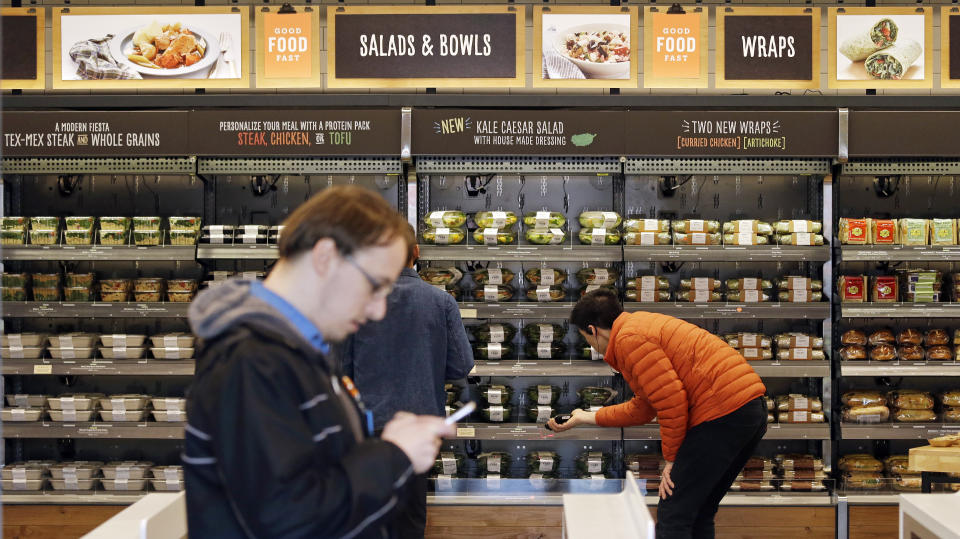
One day, regular shoppers in the U.S. will eventually pick up any item they want to buy in-store and simply walk out without ever having to interact with another human being or having to scan their items to purchase them. Amazon naturally wants to be at the forefront of that change.
As for Alexa, Wilke suggests more skills for the popular voice assistant are coming in 2018 focused on letting shoppers do more on Amazon.com simply using their voice.
“It’s early days, but you can imagine that the way we’re communicating right now would be a natural way to communicate when they’re something you want to buy,” Wilke hints.
2018 could also prove to be the year in which regulators pay closer attention to Amazon, not to mention other big tech companies like Google and Facebook, as public sentiment with Silicon Valley has soured. Just over the weekend, news emerged that Amazon could face an investigation by UK’s Advertising Standards Authority over complaints that Prime didn’t come through on its promises of “unlimited one-day delivery” with some shoppers.
Still, Wilke isn’t concerned about regulators or critics who argue Amazon is too oppressive on competition or needs to be broken up into smaller pieces. In typical Amazon fashion, he’s more concerned about winning over consumers.
“I would just direct them to the fact that we have less than 1% of worldwide retail and there are several companies, many companies actually, who are larger than us, even in retail,” Wilke emphasizes. “We’re not at a place where we should worry about that. We should be continuing to take care of customers. We, Amazon, should worry about continuing to take care of customers, invent on their behalf.”
He also points to the fact that over 50% of all sales on Amazon.com are sales done by third-party sellers and between Thanksgiving and Cyber Monday alone, 140 million products were ordered and fulfilled by third-party sellers.
“Our services are being used by third parties to build businesses independently of Amazon,” adds Wilke. “If that continues — and it will — there will be many winners in retail.”
The caveat being of course, those winners, are beholden to Amazon for its revenues, whether they like it or not.

Click here to find out more about Amazon’s culture and here to discover its plans for Alexa.
—
JP Mangalindan is the Chief Tech Correspondent for Yahoo Finance covering the intersection of tech and business. Email story tips and musings to [email protected]. Follow him on Twitter or Facebook.
More from JP:
Facebook targets 6- to 12-year-old demographic with Messenger Kids
Intuit CEO: Old-school accountants will be ‘struggling in 5 years’ because of A.I.
How Amazon quickly trains 120,000 employees for the holidays
Why the Russia ad scandal could actually be a win for Facebook
RBC analyst: Only 2 scenarios would spur investors to flee Facebook
LEAKED AUDIO: New Uber CEO Dara Khosrowshahi reveals 3 things employees should know about him
